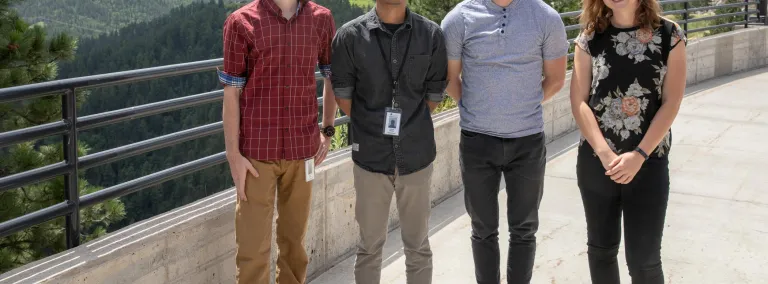Summer intern presentations focus on the big questions
Sanford Lab interns asked—and answered—fundamental questions during their end-of-the-summer presentations.
Sanford Lab’s summer interns ended their 10-week internships in science, engineering and communications with presentations about their experience working shoulder to shoulder with professionals in their fields. They shared how working at Sanford Lab has not only grown their appreciation of their own fields, but widened their scope, opening their eyes to scientific exploration of the universe.
A special thank you to the Bauer family, who sponsors the Chris Bauer Engineering Internships.
Bradley Drake is a senior engineering student at South Dakota State University, minoring in nuclear engineering, physics and sustainability. He has always had a compulsion to understand the mechanics of the world around him. As an engineering intern at Sanford Lab, Drake spent his summer considering the engineering challenges posed by a universe-probing dark matter experiment.
During Drake’s first week, Jeff Cherwinka, chief engineer for the Lux-Zeppelin Dark Matter Experiment, told him, “You’re here, not to be a full-time engineer, but to learn how engineers learn––to become a wiser, more experienced engineer.”
After showcasing some of the projects he completed with the LZ team, Drake stood back to evaluate the importance of a place like Sanford Lab. Quoting Ghandi, he said, “A small group of determined and likeminded people can change the course of history.” Drake said he is proud to be at least a part of the monumental contributions to Sanford Lab.
John Carlo Primo, a sophomore science student at Arizona State University, became interested in science as a young boy in the Philippines after watching a National Geographic documentary about the journey to the edge of the universe. As an intern with the Sanford Lab science department, Primo had hands-on experience with world-leading experiments.
Since the summer began, Primo has taken on the challenge of understanding particle physics. While he admits he has a way to go, he has already created a project of his own: creating a muon detector.
He says some people ask him why his work matters. They ask why knowing what dark matter is made of or the age of the universe really matters. His response is profound: “I say it depends on how big of a universe you want to live in. If you want to live in a small universe, comprised of your neighborhood, maybe your state, then you can. If you want to live in a big universe, made of stars and galaxies, you can as well. I, for one, want to live in a big universe.”
Erin Broberg is a senior English and Communications student at Black Hills State University. Her desire to artfully tell the story of people and places spilled into her work in the Sanford Lab communications department.
While writing and creating promotional content for Neutrino Day, Broberg learned how to better tell a story through writing, graphic design, photography and videography.
She spent her summer grappling with the question of how communications work truly impacts Sanford Lab. Education, funding, and storytelling, Broberg decided, were the biggest impacts she could work toward. “There are incredible people doing incredible things at Sanford Lab,” Broberg said. “They do them humbly, but their stories deserve to be told.”
Alec Weber is a sophomore mining engineering student at South Dakota School of Mines and Technology. During his presentation, he lifted his red, scuffed hardhat that was smattered with stickers and said, “This was new and shiny 10 weeks ago.”
His internship took him through the drifts on multiple levels of Sanford Lab, working with maintenance and safety teams. Weber helped with safety inspections, rode on top of the Yates Cage for a shaft inspection and became guide certified for the 4850 Level––the first intern to do so.
“I think the experience and opportunity I had here will last far longer than 10 weeks,” Weber said. “I now have a much better understanding of engineering and science.”
